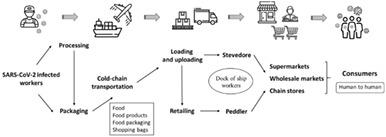当前位置:
X-MOL 学术
›
J. Food Saf.
›
论文详情
Our official English website, www.x-mol.net, welcomes your
feedback! (Note: you will need to create a separate account there.)
Antimicrobial resistance, virulence genes, and biofilm formation in Staphylococcus aureus strains isolated from meat and meat products
Journal of Food Safety ( IF 1.9 ) Pub Date : 2021-09-24 , DOI: 10.1111/jfs.12933 Kobra Abbasi 1 , Elahe Tajbakhsh 1 , Hassan Momtaz 1
Journal of Food Safety ( IF 1.9 ) Pub Date : 2021-09-24 , DOI: 10.1111/jfs.12933 Kobra Abbasi 1 , Elahe Tajbakhsh 1 , Hassan Momtaz 1
Affiliation

|
Staphylococcus aureus is an important food pathogen that has the ability to form biofilms. This pathogen has been implicated in foodborne outbreaks associated with the consumption of meat and meat products. Since the role of meat products as reservoirs of antimicrobial resistant S. aureus and biofilm formers has not been studied, this research was conducted to assess the incidence, antimicrobial resistance, and presence of biofilm-forming genes in S. aureus bacteria from meat and meat products. For this purpose, 440 samples of meat and meat products were randomly collected from supermarkets of Shahrekord city, Iran. S. aureus isolates were highlighted and identified through biochemical tests. All S. aureus isolates were profiled for susceptibility to 14 antibiotics and the corresponding resistance genes were searched. The quantification of biofilm formation followed by a screening of biofilm formation encoding genes was done. Of the 440 samples collected, 61 were found to contain S. aureus. The incidence of S. aureus among the beef meat (16/61) was the highest followed by its incidence in sausage (10/61) and lunch meat (9/61). At least one isolate of S. aureus carries one of the following resistance gene blaZ, mecA, tet K, linA, tetM, erm A, ermB, and aac A-D. High distribution of icaA, icaB, icaC, icaD, clfB, and clfA, biofilm formation genes and Enterotoxin encoding genes sea, seb, sec, and sed. The ability of biofilm production and the presence of virulence determinants in the genome of S. aureus can contribute to their pathogenicity. This research demonstrated the roles of meat and meat products as reservoirs of biofilm-forming and antimicrobial-resistant strains of S. aureus. This poses a food safety and public health problem. However, further work needs to be done to better understand the implication of icaABCD biofilm forming genes present in S. aureus from meat and meat products in their resistance.
中文翻译:

从肉和肉制品中分离的金黄色葡萄球菌菌株的抗菌素耐药性、毒力基因和生物膜形成
金黄色葡萄球菌是一种重要的食物病原体,具有形成生物膜的能力。这种病原体与食用肉类和肉制品相关的食源性疾病暴发有关。由于尚未研究肉制品作为抗微生物金黄色葡萄球菌和生物膜形成菌的储存库的作用,因此进行本研究是为了评估来自肉类和肉类的金黄色葡萄球菌细菌中生物膜形成基因的发生率、抗微生物药物耐药性和生物膜形成基因的存在产品。为此,从伊朗沙赫雷科尔德市的超市中随机收集了 440 份肉类和肉制品样品。通过生化测试突出并鉴定了金黄色葡萄球菌分离株。所有金黄色葡萄球菌分离株对 14 种抗生素的敏感性进行了分析,并搜索了相应的抗性基因。对生物膜形成进行量化,然后对生物膜形成编码基因进行筛选。在收集的 440 个样本中,61 个被发现含有金黄色葡萄球菌。牛肉中金黄色葡萄球菌的发生率最高(16/61),其次是香肠(10/61)和午餐肉(9/61)。至少一种金黄色葡萄球菌分离株带有下列抗性基因blaZ、mecA、tet K、linA、tetM、erm A、ermB和aac AD 之一. 的高分布ICAA,ICAB,廉署,ICAD,CLFB,和clfA,生物膜形成基因和肠毒素编码基因海,SEB,秒,和sed的。生物膜产生的能力和金黄色葡萄球菌基因组中毒力决定簇的存在可导致其致病性。这项研究证明了肉和肉制品作为金黄色葡萄球菌生物膜形成和抗微生物菌株库的作用. 这构成了食品安全和公共卫生问题。然而,需要做进一步的工作以更好地了解存在于来自肉和肉制品的金黄色葡萄球菌中的icaABCD生物膜形成基因对其抗性的影响。
更新日期:2021-09-24
中文翻译:

从肉和肉制品中分离的金黄色葡萄球菌菌株的抗菌素耐药性、毒力基因和生物膜形成
金黄色葡萄球菌是一种重要的食物病原体,具有形成生物膜的能力。这种病原体与食用肉类和肉制品相关的食源性疾病暴发有关。由于尚未研究肉制品作为抗微生物金黄色葡萄球菌和生物膜形成菌的储存库的作用,因此进行本研究是为了评估来自肉类和肉类的金黄色葡萄球菌细菌中生物膜形成基因的发生率、抗微生物药物耐药性和生物膜形成基因的存在产品。为此,从伊朗沙赫雷科尔德市的超市中随机收集了 440 份肉类和肉制品样品。通过生化测试突出并鉴定了金黄色葡萄球菌分离株。所有金黄色葡萄球菌分离株对 14 种抗生素的敏感性进行了分析,并搜索了相应的抗性基因。对生物膜形成进行量化,然后对生物膜形成编码基因进行筛选。在收集的 440 个样本中,61 个被发现含有金黄色葡萄球菌。牛肉中金黄色葡萄球菌的发生率最高(16/61),其次是香肠(10/61)和午餐肉(9/61)。至少一种金黄色葡萄球菌分离株带有下列抗性基因blaZ、mecA、tet K、linA、tetM、erm A、ermB和aac AD 之一. 的高分布ICAA,ICAB,廉署,ICAD,CLFB,和clfA,生物膜形成基因和肠毒素编码基因海,SEB,秒,和sed的。生物膜产生的能力和金黄色葡萄球菌基因组中毒力决定簇的存在可导致其致病性。这项研究证明了肉和肉制品作为金黄色葡萄球菌生物膜形成和抗微生物菌株库的作用. 这构成了食品安全和公共卫生问题。然而,需要做进一步的工作以更好地了解存在于来自肉和肉制品的金黄色葡萄球菌中的icaABCD生物膜形成基因对其抗性的影响。











































 京公网安备 11010802027423号
京公网安备 11010802027423号